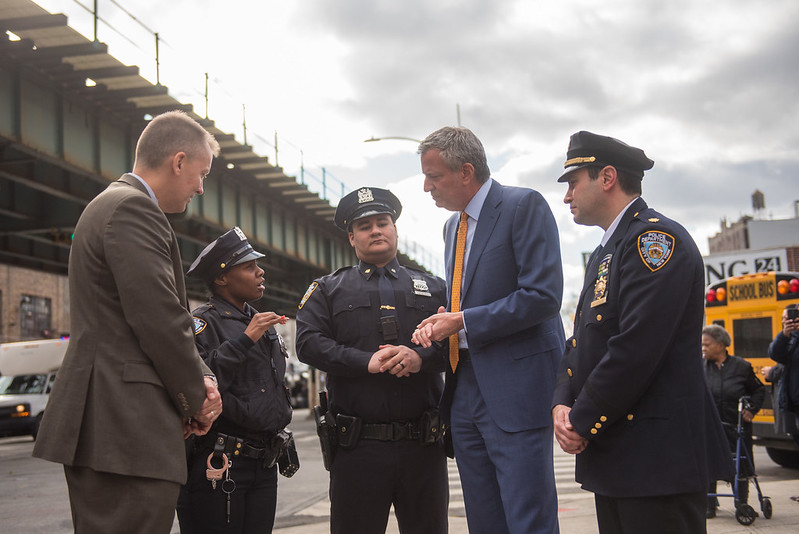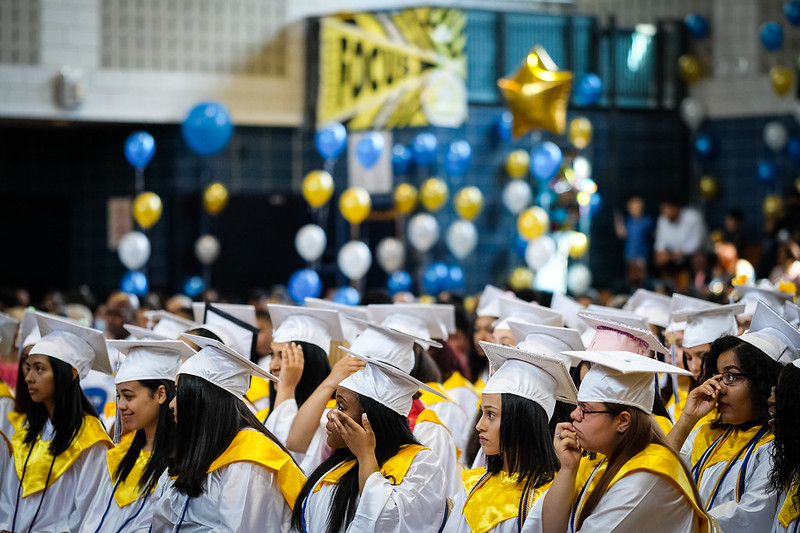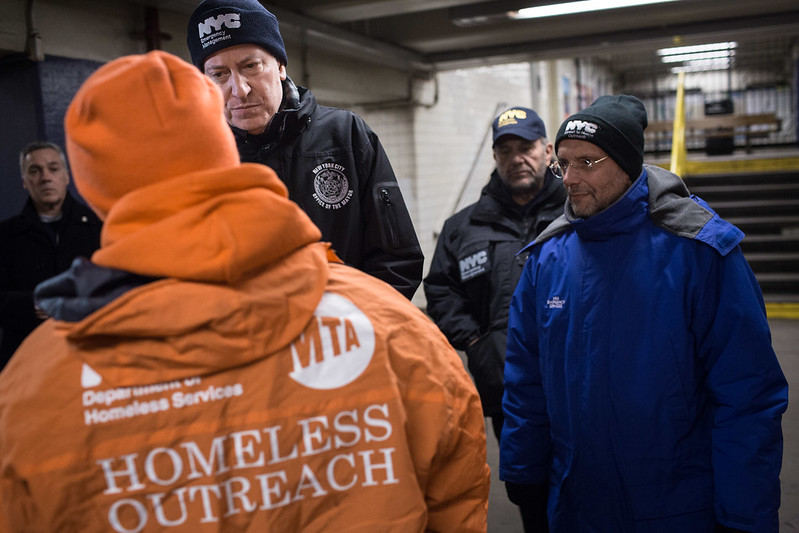Supporting Law Enforcement and Reforming the NYPD are Not Mutually Exclusive — I Know From Experience

Mayor de Blasio and the NYPD in focus (photo: Michael Appleton/Mayor's Office)
When I joined the NYPD in 2013, I was an unlikely candidate for law enforcement. Nearly a decade earlier, during the 2004 Republican National Convention, I was a passerby arrested at a protest in Union Square. At the invitation of the New York Civil Liberties Union, I joined a class action lawsuit against the City related to those widespread arrests. Then, for several years after graduating from Harvard Law, I worked at a law firm and volunteered as a board member at the Bronx Defenders, a zealous criminal defense organization.
Many colleagues and friends were surprised when I joined the NYPD as a lawyer in the Intelligence Bureau, which had some vocal critics, including litigants who alleged the City had unfairly targeted Muslim communities in its counter-terrorism efforts. However, I saw it as an amazing opportunity to support the NYPD’s public safety mission, while also scraping away at any unfair or overly-broad practices.
Indeed, I spent much of my time at the Department over the past several years meeting with lawyers and advocates to discuss their concerns, share information about department practices, and work towards policy solutions that balance public safety and civil liberties, especially in the context of protests and other political activity. In these negotiations, the parties around the table often disagreed, but the dialogue was, almost invariably, respectful and productive, and we all left better informed and more appreciative of one another’s perspectives.
When I moved to my most recent role as counsel in the Police Commissioner’s Office, which I left a week before George Floyd’s death, I continued working on issues that require balancing civil rights and public safety, such as facial recognition and the local DNA database. Significantly, I was not a lone soldier in this work, but rather found it widely supported throughout the organization, especially at its highest levels. NYPD leaders often asked important, thoughtful questions: Is this policy fair, and is it the right thing to do? And when devising policy in response to social problems like drug abuse or mental illness: How do we really help people?
Following the senseless death of Mr. Floyd in Minnesota, the positive standing the NYPD enjoyed among most New Yorkers was overtaken by a tsunami of anti-police sentiment driven by a handful of recent brutal incidents. That these incidents occurred hundreds of miles from New York City did not blunt the rage unleashed against police officers in New York. The unrest was amplified by the social dislocation, anxiety, and hardship wrought by the pandemic. People were open to rage, had plenty of time to do it, and the NYPD presented a highly visible, omnipresent target.
The rage and vitriol directed towards officers was astounding and without modern precedent in New York. Yet through this windstorm, the NYPD sought to protect the rights of peaceful protesters and worked hard to distinguish among the various currents of activity pulsing through the city: the thousands marching in support of the Black Lives Matter movement, the violent agitators bent on destabilizing city life through arson and vandalism, and the scores of opportunists brazenly looting and burglarizing city businesses.
Even so, scorn from the public and many media outlets mounted and whipped, creating an echo chamber in which seemingly all police officers—even those at the NYPD, a majority-minority department for over a decade—were viewed as suspected racists or oppressors. Worse still, many public officials in New York City pandered to the protesting crowds, even though they have access to facts that inform a more nuanced view.
Certain voices were greatly amplified and some rightly so. However, others were excluded from the conversation about policing, including many people who live and work in New York and put a premium on public safety. They do not want to “throw the baby out with the bath water” when it comes to the NYPD and the maintenance of public safety. Some privately emailed me, expressing dismay. No doubt people of this mindset express their views in muted tones, if at all, for fear of being targeted and labeled by the pernicious, intolerant political culture that marks our day.
But make no mistake: despite current false narratives that police are broadly racist, trigger-happy, or both, it is not morally inconsistent to respect police (and the rule of law) and to oppose brutality and prejudice in all its forms. Yet many people feel backed into choosing between two positions: pro-law enforcement or anti-racism.
This stark choice is forced on us by political opportunists and by individuals who are prone to selectively defending free speech while seeking to ostracize people with opposing views. They rarely mention crime victims or the NYPD’s role in suppressing violent crime. In our increasingly brittle political environment, it’s unsurprising that few, even among our elected leaders, seek to articulate a more nuanced, fact-based view.
That is not to minimize the reality that some officers exhibit prejudiced behavior or even engage in criminal violence. But these officers are the few, not the many, and clear-cut remedies exist: better training, and where necessary, discipline or criminal prosecution. What we know is that blaming a whole group of people, who share a race, religion, or in this case a vocation, for the bad acts of a few leads to unjust results and divisiveness. But this is what has happened.
Scathing, dehumanizing depictions of our City’s officers by certain activists, politicians, and media outlets bear no resemblance to the Department I came to know through years of service. Rather its members are predominantly committed, hardworking public servants. They come from many different racial, ethnic, and religious backgrounds. Most come from working-class backgrounds. Many are immigrants or the children of immigrants. While many among them are idealistic, their job is complicated by harsh realities with historical underpinnings, including significant racially-disparate patterns in crime victims and perpetrators.
The NYPD that I know responds to criticism, continually strives for improvement, and is fundamentally guided by a commitment to the public good that we can all respect. Forced to decide between the NYPD and standing against brutality and racism, I choose both.
***
Ashley Waters served as NYPD Counsel for Intelligence Affairs from 2013 to 2018 before becoming Counsel to the NYPD Police Commissioner from 2018-2020. She is now an adjunct professor of law at University of Virginia School of Law.
***
Have an op-ed idea or submission for Gotham Gazette? Email This email address is being protected from spambots. You need JavaScript enabled to view it.
We are Justice-Involved Women of Color; And We are 2020 College Graduates and Innovators

Graduates (photo: Edwin J. Torres/Mayor's Office)
Plagued by a pandemic and confronted by a national outcry against racial injustice, our final semester in college was challenging at best. As nontraditional students and Black women directly impacted by a deeply-flawed criminal legal system, we are no strangers to adversity. We consistently prove, time and again, that we can succeed despite our backgrounds.
That success is predicated on an unmovable foundation that reframes our relationship with the world and the issues we face today – a college degree. A college degree is transformative. A college degree is a means to a better life that reverberates hope and opportunity across generations and throughout communities.
Even in the current economic climate, our degrees provide a critical buffer against unemployment and financial volatility. Not only does this stabilizing effect demonstrate the importance of higher education to our families but it also increases the chances relatives and others we know will seek out a college degree, breaking the cycle of multi-generational poverty.
However, while the motivation to earn our degrees was always present, the systemic barriers limiting our ability to successfully achieve that outcome were pervasive. How would we pay for college? What colleges and universities will even accept us?
These questions, while not uncommon for most Americans, become even more damning when you have a criminal conviction. Just ask the millions of Americans currently struggling to surmount the lifetime of collateral consequences that come with their conviction status. Most will never find the crucial social supports required to access opportunities that extend beyond their present circumstances.
Our pathway to and through college would not have been possible without community-based organizations that delivered the necessary resources and tools to help guarantee our success. These spaces offered structure and community that empower women of color to recognize our worth and, ultimately, to achieve our goals.
They provided one-on-one academic counseling that guided us through institutional bureaucracies, community meetings that gave us safe spaces to ask difficult questions, and advocacy training that taught us how to build a movement. All of the programming was tailor-made for justice-involved women like us.
We became part of a sisterhood of women supporting women and our voices, which often go unheard, were not only heard but valued. This enabled us to break out of the box society had put us in and define ourselves for who we truly are – women who can create change.
That change includes empowering other marginalized people to embrace their intimate understanding of oppression, mass criminalization, and intergenerational poverty. In doing so, they too can recognize that they are best positioned to find the most effective solutions to the problems facing their families and communities.
Coupled with our lived experience and the full power of our degrees, we are committed to creating similar spaces that teach other justice-involved people that their criminal conviction status is not a terminal diagnosis. A space where people with criminal histories can achieve the same confidence and credentials to realize their full potential and pay it forward.
Robert Merton, considered to be the founding father of modern sociology and a contributor to the subfield of criminology, created the Strain Theory — a theory that puts society in five classes: conformity, ritualism, retreat, rebellion, and deviance. A deviant was once considered a criminal, people whose behavior fell out of society's norms. Now, when you look up Merton’s theory, deviant is replaced with innovator: people who have created promise, opportunities outside of society's norms.
As we’ve replaced our caps and gowns with masks and cardboard signs, we’ve begun our new, fully realized futures, invoking our role as innovators. With our degrees in hand, we’ve set out on a mission to build a better path for those that come after us by disrupting and dismantling a system where only few can succeed. We do not forget our past, but now, because of our education, we demand access to a promised future that provides opportunity for all.
***
Chermaine Black graduated this year from Columbia University with her Master of Social Work and is an alumna and 2020 Valedictorian of College & Community Fellowship – an organization working to help justice-involved women earn their college degrees. Shannon McCarroll graduated this year from Lehman College with her Bachelor of Arts in Sociology and is an alumna and 2020 Salutatorian of College & Community Fellowship.
***
Have an op-ed idea or submission for Gotham Gazette? Email This email address is being protected from spambots. You need JavaScript enabled to view it.
Removing NYPD from Homeless Outreach is a Long-Overdue Positive Step; Here’s What Must Come Next

Mayor de Blasio with homeless outreach (photo: Michael Appleton/Mayor's Office)
As the city gradually reopens, we’ve seen many homeless New Yorkers kicked off the subways without being offered a safe, private alternative place to sleep. In some recent cases, we have seen police officers use unacceptable violence to drag homeless New Yorkers off the train. Fortunately, after repeated calls from homeless New Yorkers and advocates, New York City finally announced homeless outreach will be shifted away from the NYPD and be done entirely by the City’s social services agency.
Though we are grateful the city made a right decision after months of failed policies, significant damage has been done since the overnight subway shutdowns began in May. Removing police from homeless outreach must be only the first step -- now, we need to gain the trust of our homeless neighbors and actually offer them the safe shelter options and permanent housing they need and deserve.
For months, we have raised concerns about the subway shutdowns, only for Mayor de Blasio to brush off our criticism and spin his own message. After the first three weeks of the nightly subway shutdowns, the mayor boasted that 1,700 people were engaged, 506 unique individuals accepted shelter placement, and 281 of them remained in shelters. He declared success, and has continued to point to the nightly shutdowns as a welcome opportunity to engage homeless New Yorkers.
According to the Department of Homeless Services, between May 5 and July 19, 2,823 individuals accepted referrals to shelters from the subways, 955 individuals accepted placements after they were transported from the subway, and 437 of these individuals remain in shelter placements. Yet, the mayor has failed to acknowledge the reasons why people bed down in the subways in the first place, and has ignored the distrust and anxiety homeless New Yorkers experience due to being kicked off the trains every night.
For example, hours before the first nightly subway shutdown was scheduled to begin, we received a desperate email from a homeless New Yorker who had been sleeping in the subway system for two years: “Please, if you can find a way to get me into one of these hotel rooms, I’d be very grateful. Tonight, I may visit the ER, and fake some chest pains, just to have a place to relax for a bit. But, I can't do that every night. I legitimately have PTSD from the shelter system, from my last time on Wards Island. It is not an option for me. I am begging you, if you can, please help me.”
Despite the existence of tens of thousands of vacant hotel rooms, Mayor de Blasio has largely resisted calls to offer direct hotel placements for people being kicked off the subways. He has argued that they could not get services in hotels – contrary to the belief of several outreach workers – and instead offers them transportation to the same crowded, congregate shelters many of them have made a conscious decision to avoid due to the risk of exposure to COVID-19, among other reasons. In recent weeks, the city has opened some low-threshold shelter beds in hotels, but they have not been consistently offered to everyone being removed from the subways.
Even so, Mayor de Blasio has gone on about the number of homeless New Yorkers brought to shelters or hospitals without mentioning the overcrowded chaos often found in shelters.
When these individual human stories of the subway shutdown are reduced to numbers, the reality can be easily distorted, even portrayed as a success. Through the past few months, Coalition for the Homeless monitors have witnessed homeless New Yorkers being kicked off the subway without being given adequate alternatives. Police, rather than outreach workers, are usually the ones who wake people and tell them to leave the train. In fact, at many stations, there are only police officers present, no outreach workers.
Mayor de Blasio’s rosy proclamations ignore the fact that shuffling people between crowded congregate shelters and hospitals during a deadly pandemic is no victory. The role of police in the nightly subway shutdown has been one more example of the mayor’s reliance on the NYPD to move homeless New Yorkers along, rather than addressing the root causes of homelessness -- and his defense of aggressive police actions against homeless New Yorkers reveals his failure to grasp the negative ramifications of these misguided policies, which understandably make people more distrustful of outreach workers and others seeking to help them.
Now, with outreach finally shifted away from the NYPD and into the hands of social services, we hope to see an end to the criminalization of homelessness. But we must go further and give outreach workers the critical tools needed to help homeless New Yorkers obtain permanent housing, a vital resource that, now more than ever, fundamentally serves as health care. New York City must provide housing assistance to help people relocate out of the transit system, off the streets, and out of crowded shelters, and into homes of their own.
For years, we have called on Governor Cuomo and Mayor de Blasio to invest in housing as a solution to homelessness. We have long argued that to reduce the tragedy of people sleeping on the streets and in the subways, they must be offered somewhere better to go. New Yorkers should not have to endure nightly removal from the subways without being provided with a safe, private place to protect themselves.
Moving away from police reliance is a massive step. We owe it to our homeless neighbors to keep fighting for something better, during and after the pandemic.
***
Jacquelyn Simone is Policy Analyst at Coalition for the Homeless. On Twitter @NYHomeless.
***
Have an op-ed idea or submission for Gotham Gazette? Email This email address is being protected from spambots. You need JavaScript enabled to view it.




